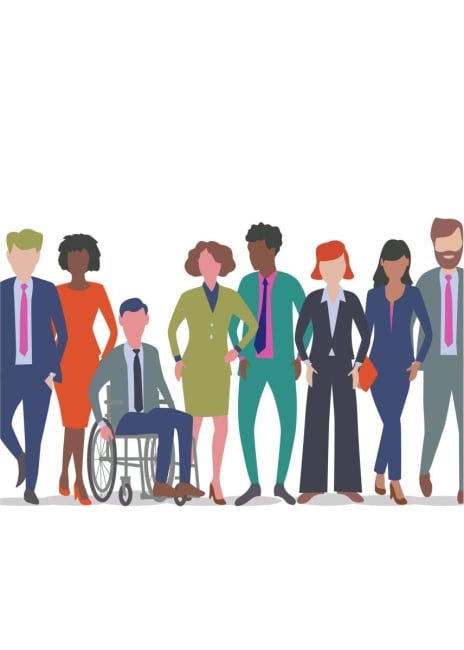You have /5 articles left.
Sign up for a free account or log in.

smartboy10/DigitalVision Vectors/Getty Images
Take a moment to envision your ideal higher education leader. What attributes come to mind?
I ask a similar question in a sexual ethics class I teach—but there, I ask students to identify the characteristics of their ideal partner. When they’re done, I ask if anyone described a person with a disability. After more than 20 years of teaching, I have never encountered a student who says yes.
The final exam includes a question asking students to reflect on the most important things they learned in the course. Students almost always return to the ideal-partner class exercise. They write that that was the moment when they recognized their own ableism and the ableist cultural standards around beauty, attractiveness and what is deemed “normal.”
My guess is that you’re not that different from my students.
Was the college or university leader you imagined blind, deaf, neurodivergent, mentally ill, using a wheelchair, stuttering or walking with a cane, crutches or leg braces? Probably not.
What explains our inability to imagine partners—or college leaders—with disabilities? More importantly, why does it matter? Why do we need higher ed leaders with disabilities?
Ableism—and ableist institutional attitudes and policies—explains part of why my students don’t envision disabled partners, or why you most likely didn’t imagine disabled a leader. Lack of representation is another piece of the explanation. Have you ever worked for a president, provost or vice president with an apparent disability, or encountered leaders with disabilities in any space in higher education?
Probably not, but of course, this does not necessarily mean that leaders with disabilities do not exist. Rather, it more likely means that if a leader lives with a disability, they hide it. The two questions we’re left with, then, are: What is it about the culture of the academy that does not encourage people with disabilities to pursue leadership opportunities, and why do people with disabilities in leadership positions in higher education often find it necessary to keep their disabilities hidden?
Perhaps it’s because they’re rarely thought about in the first place.
A recent analysis by Inside Higher Ed, published in February with the title “Diversity on the Rise Among College Presidents,” describes an increase in the percentage of racial and ethnic minorities hired into college and university presidencies during the 18 months following the murder of George Floyd and the 2020 rise of the Black Lives Matter movement. The data show that 35.4 percent of new presidential hires in the 18 months after Floyd’s killing were racial and ethnic minorities, compared to 22 percent in the 18 months before that. The Inside Higher Ed analysis briefly explores “other highlights of the data,” reviewing factors such as gender, previous jobs and geography. Missing from these “other highlights”—indeed missing from the entire discussion—is any mention of disability.
The American Council on Education’s American College President Study, conducted every five years, also lacks data on the number of presidents with disabilities. A website for the study notes that an interactive data tool that accompanies the report “offers opportunities to look ahead at when the college presidency might reach gender parity or racial parity,” but there is no information on presidents with disabilities.
Efforts to increase racial and ethnic diversity and representation among faculty, staff and administrators are laudable. It is critical for students of color to see reflections of themselves in all areas and at all levels of the institution. It is equally important for students with disabilities to find role models who reflect their life experiences and realities. Like students of color at many institutions, students with disabilities rarely get this opportunity.
The National Center for Education Statistics found that 19 percent of all undergraduate students reported having a disability in the 2015–16 academic year. That means almost one-fifth of all undergraduate students identified as disabled. These figures don’t include those students who opted not to disclose their disability status, nor do they reflect the ways COVID has since impacted the mental and physical health of students. It is probably safe to assume that the percentage of students living with some form of disability is higher than reported. When and where will these students find data on higher education leaders reflecting their life experiences? More importantly, when and where will these students find disabled leaders?
Few people even appear to be asking questions about disabled leaders; it is difficult to find any data. What this communicates to students with disabilities is that there are no leaders with disabilities in higher education (surely a fallacy) and, more distressingly, that becoming a leader in higher education is not a path available to them. Students may encounter more faculty with disabilities, but statistics on disabled faculty are also scarce. According to a United Nations fact sheet on persons with disabilities, people who live with disabilities make up the largest minority group worldwide.
But representation is just part of the answer to why higher ed needs leaders with disabilities. As witnessed through efforts to address gender and racial inequities, most institutions did not make meaningful systemic or structural change until people of color and/or women instigated review and revision at a policy level.
Institutions change when their policies change. Policies become more inclusive and equitable when leaders center justice. What many institutions are discovering is that policy review and revision grounded in principles of disability justice benefits not only people with disabilities, but everyone. Centering disability justice creates opportunities for questioning which bodies—disabled or not—are absent from decision-making spaces.
The need for representation and policy review and revision are two answers to why higher ed needs leaders with disabilities. Efforts to address racial and gender gaps reveal that this type of change moves at a glacial pace and is hard to achieve.
Acknowledging the gap and creating opportunities for honest conversation about why gaps exist, who is negatively impacted by these gaps and how to begin to address the gaps is a good starting point for institutions committed to diversity, equity, inclusion and justice. The status quo sustains and perpetuates itself until someone pushes back and asks, “Who is missing here?”
Recognizing implicit bias about disability and implementing procedures for correcting it is another good starting point. Many colleges and universities are creating processes for confronting implicit bias around gender, race and ethnicity; incorporating disability into these conversations and engaging in honest discussion about how biases influence hiring is another necessary step.
Why does higher ed need leaders with disabilities? Because students with disabilities need to find themselves in leadership positions, and because higher ed needs leaders who are willing and able to confront injustice and inequity in all its manifestations.
Take a moment to envision your ideal higher education leader. What attributes come to mind?








